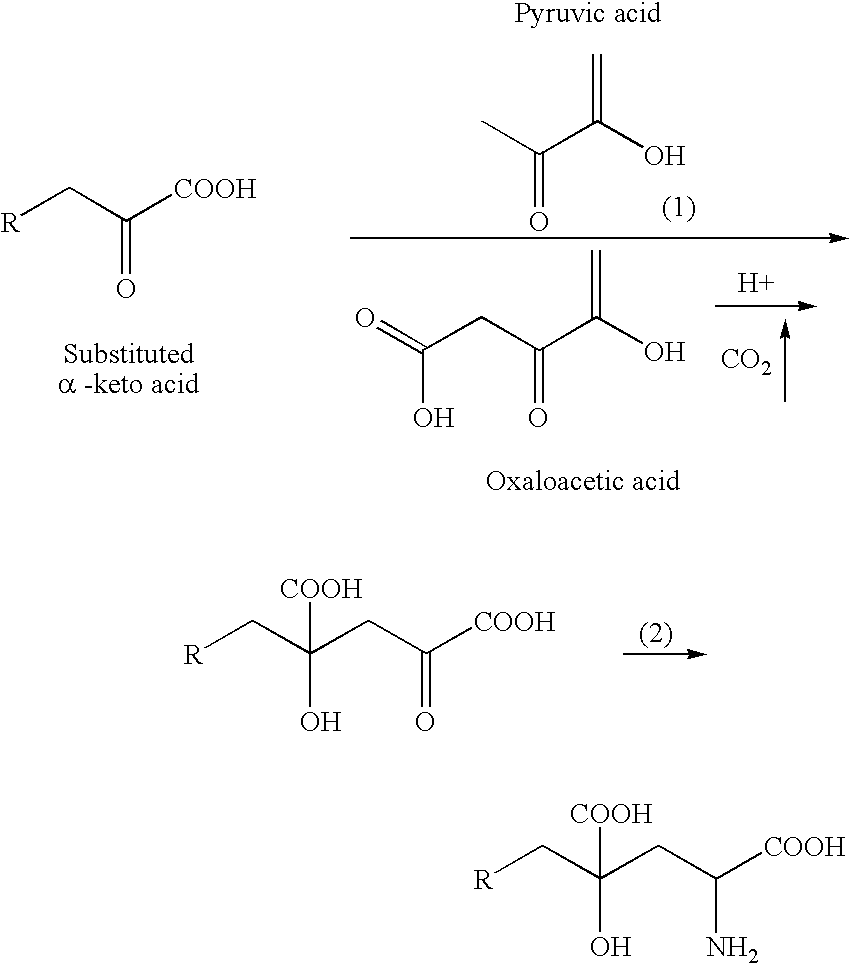Novel aldolase and production process of substituted alpha-keto acids
- Summary
- Abstract
- Description
- Claims
- Application Information
AI Technical Summary
Benefits of technology
Problems solved by technology
Method used
Image
Examples
example 1
[I] Screening of Microorganisms Having Aldolase Activity for PHOG
[0206] Microbial strains having aldolase activity using 4-phenylmethyl-4-hydroxy-2-oxoglutarate (PHOG) as a substrate were screened for.
[0207] Microorganisms (bacteria, yeast) were inoculated onto bouillon plate medium (Eiken Chemical Co., Ltd.) and cultivated at 30° C. for 24 hours. The microorganisms were then inoculated onto plates containing 0.5 g / dl glycerol, 0.5 g / dl fumaric acid, 0.3 g / dl yeast extract, 0.2 g / dl peptone, 0.3 g / dl ammonium sulfate, 0.3 g / dl K2HPO4, 0.1 g / dl KH2PO4, 0.05 g / dl MgSO4.7H2O, 0.25 g / dl sodium phthalate and 2 g / dl agar powder (pH 6.5) followed by cultivating at 30° C. for 24 hours. The resulting microbial cells were inoculated into a reaction solution comprised of 100 mM Tris-HCl (pH 8.0), 50 mM PHOG, 1 mM MgCl2, 5 mM potassium phosphate solution (KPi) and 1% (v / v) toluene to wet cells weight of about 1% (w / v), and incuvated at 30° C. for 24 hours. The concentration of free pyruvic ac...
example 2
High-level Expression of IHOG-Aldolase in E. coli (Part 2)
(1) Construction of Plasmid pTrp4 Containing trp Promoter and rmB Terminator
[0246] The promoter region of the trp operon in a chromosomal DNA of E. coli W3310 by PCR with the oligonucleotides shown in Table 8 as primers (combination of SEQ ID No: 10 and 11), and the resulting DNA fragment was ligated into a pGEM-Teasy vector (Promega). E. coli JM109 was then transformed with this ligation mixture, and a strain was selected among ampicillin-resistant strains that had the desired plasmid in which the trp promoter was inserted in the opposite orientation of the lac promoter. Next, the DNA fragment containing trp promoter obtained by treating this plasmid with Eco0109I / EcoRI was ligated with the product of treating pUC19 (Takara) with Eco0109I / EcoRI. E. coli JM109 was then transformed with this ligation mixture, a strain was selected among ampicillin-resistant strains that had the desired plasmid, and that plasmid was named pT...
example 3
Cloning of IHOG-Aldolase Derived from Pseudomonas coronafaciens strain AJ2791
(1) Preparation of Chromosomal DNA
[0249]P. coronafaciens strain AJ2791 was cultivated at 30° C. overnight using 50 ml of bouillon medium (pre-cultivation). 5 ml of this culture was inoculated into 50 ml of bouillon medium. After the cultivation until the late logarithmic growth phase, 50 ml of culture was centrifuged (12000×g, 4° C., 15 minutes) to recover the microorganisms. A chromosomal DNA was then prepared according to established methods using these microbial cells.
(2) Cloning of Full Length Gene by Southern Analysis and Colony Hybridization
[0250] Cloning of IHOG-aldolase gene derived from P. coronafaciens strain AJ2791 (hereinafter, “PcALD”) was performed by Southern hybridization analysis and colony hybridization with IHOG-aldolase gene derived from P. taetrolens strain ATCC4683 as a probe. The full length of IHOG-aldolase gene was amplified by PCR from a chromosomal DNA of P. taetrolens ATCC4...
PUM
| Property | Measurement | Unit |
|---|---|---|
| Temperature | aaaaa | aaaaa |
| Temperature | aaaaa | aaaaa |
| Acidity | aaaaa | aaaaa |
Abstract
Description
Claims
Application Information
 Login to View More
Login to View More - R&D
- Intellectual Property
- Life Sciences
- Materials
- Tech Scout
- Unparalleled Data Quality
- Higher Quality Content
- 60% Fewer Hallucinations
Browse by: Latest US Patents, China's latest patents, Technical Efficacy Thesaurus, Application Domain, Technology Topic, Popular Technical Reports.
© 2025 PatSnap. All rights reserved.Legal|Privacy policy|Modern Slavery Act Transparency Statement|Sitemap|About US| Contact US: help@patsnap.com



